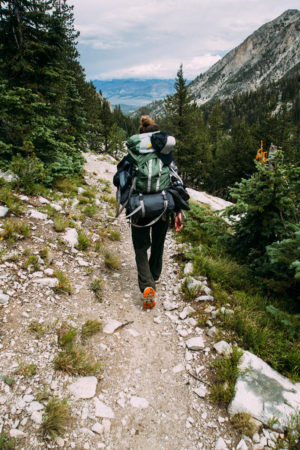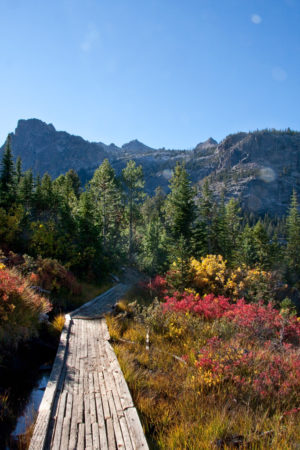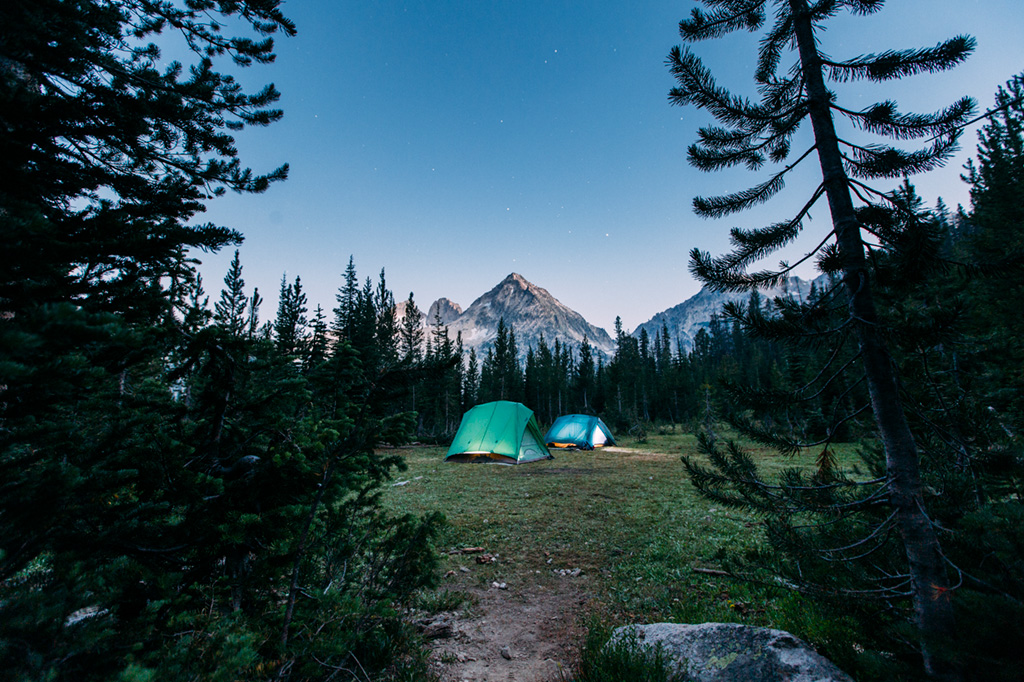Ah, fall. The aspen are shivering and leaves quaking in their last vestiges of golden glory before winter winds strip them naked. Tiny icicles clinging to the ends of pine needles glimmer in the dim light of the quarter moon. And the air is crisp, invigorating.

Hiker in the Sawtooth Mountains. Photo by Ray J. Gadd
Some Wood River Valley residents, like Dean Paschall, would rather backpack in fall than any other season. Popular trails, such as that from Redfish Lake to Cramer Lakes, are emptied of people—and bugs. And yellow and red leaves splashed against Idaho’s azure skies give familiar scenery a different look.
Plus, there’s no need to stay up until 11 to gaze at the Milky Way.
“Fall is spectacular,” said Paschall, who started Community School’s outdoor program in 1980. “I love the crispness in the air. It’s cooler at night so you sleep well. And everything seems a little calmer, a little easier.
“Another nice thing is that the water levels are down,” he added. “My 15-year-old son wanted to do a 58-mile solo backpacking trip this summer in the Sawtooth Mountains and the creek crossings scared me to death. They weren’t just deep, deep. They were chest deep.”
Of course, fall backpacking comes with some unique challenges backpackers don’t have to worry about during summer. Foremost is the shorter days.
Andy Munter, who owns Backwoods Mountain Sports, said he never goes on a fall backpacking trip without a tent and either a Crazy Creek chair or a Therm-a-Rest chair that can be transformed into a sleeping pad.
“You don’t want to spend 12 hours lying down—a good book and chair are a must,” he said.
Backpackers can read that book by a Solar Inflatable Lantern that packs into the size of a big deck of cards. It provides eight hours of light and can be recharged on top of the pack while hiking.
Filtering water is just as important during fall as during summer, said Michele Krankkala, a retail clerk at The Elephant’s Perch. MSR’s Pocket-Sized Water Filter weighs just five ounces. And the Grayl Ultralight Purifier weighs just 10.9 ounces but removes particulates.
“When you have water as high as we did this summer, it’s good to have a purifier that removes particulates,” said Krankkala. “They’re pretty much everywhere any time you have higher water.”
Come bed time, a Nemo fillo pillow provides the same level of comfort as that pillow at home and weighs just nine to 12 ounces.

A puncheon across a boggy section of trail on the Alice/Toxaway loop. Photo by Matt Liedeker
With mornings a little chilly, JetBoil cooking systems can have that cuppajoe ready in no time. And it comes in several sizes from MiniMo to Sumo.
“I always take ski poles, as well, to help me keep my footing in the event of snow,” said Sun Valley native Pam Street.
While it’s tempting to lounge around a fire on a crisp fall night, pay attention to regulations, cautioned Munter. Munter carries a fire blanket and a foil turkey roaster, which he can pack compactly. He puts a little sand in it before setting sticks on top, then lights it with a lighter around which he’s wrapped duct tape.
“Duct tape is a great fire starter,” he added.
Paschall took hundreds of Community School students on fall backpacking trips to Baker Lake, which sits under rose-colored cliffs about 1.5 miles from the trailhead.
Hell Roaring Lake offers an easy five-mile hike without a lot of vertical gain—and without the bugs that early-season backpackers encounter. Other popular fall backpacking destinations near Sun Valley include the five-mile hike to the green waters of Prairie Lake 19 miles north of Ketchum and the four-mile hike to nearby Miner Lake, which sits under the pointed top of Norton Peak.
“I like to backpack in the vicinity of Williams Peak near Redfish Lake because of the beautiful display of aspen in the Sawtooth Mountains every fall,” added Street.
Tips for Fall Trips
- Consider a sleeping pad a necessity as it will provide insulation against the cold ground. And they’re getting lighter and lighter. NeoAir mattresses, for instance, come in different lengths, sizes and thicknesses and weigh 20 percent of what self-inflating mattresses weigh.
- Pitch your tent on a hill, rather than in a hollow, as warm air rises while cold air settles.
- Keep your water inside your tent to keep it from freezing at night.
- Don’t leave your boots out at night, especially if they’re damp from sweat or wading through creeks. Keep them in a stuff sack close to your sleeping bag to keep them from freezing.
- To warm up your tent, light a candle.
- Open a vent on your tent to prevent condensation.
- Wear a Polartec balaclava to cover your head and neck—everything but your eyes—to keep your head warm while sleeping.


